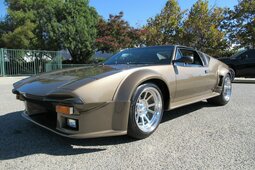Explore the possibility of an automotive industry without the iconic Porsche 911, a concept considered by Porsche in the 1970s despite its success. Discover how Porsche anticipated significant market shifts as the 1980s neared, questioning the future demand for this classic model derived from the Beetle's evolution.
Learn about the lesser-known fact that the Porsche 928 initiative, predating the more economical, VW-based 924, was conceived in 1972 under the leadership of Dr. Ernst Fuhrmann. This project aimed to create a groundbreaking luxury coupe, marking a departure from Porsche's traditional air-cooled designs to a front-mounted, water-cooled V8 engine, setting new standards in the company's history.
The 1977 debut of the Porsche 928 at the Geneva Motor Show marked a significant milestone, showcasing its avant-garde design with a sleek body, innovative flip-up headlights, and integrated bumpers. This groundbreaking model was highly praised, even earning the prestigious European Car of the Year award, a rare accolade for a sports car. As Porsche ventured into the 1980s, its expanded model lineup, featuring the affordable 924, the classic 911, and the flagship 928, aimed to captivate potential Jaguar XJS and Mercedes-Benz SL enthusiasts.
The Porsche 928 was truly high-tech for its time, featuring aluminium body parts, a Weissach axle rear suspension arrangement, and plenty of electrical adjustments inside – even the steering wheel and dash console adjusted as one. The 4.5-litre V8 engine generated a solid 240 PS, which might not be the most by Porsche standards, but was still enough to reach 100 km/h in 7 seconds and steadily accelerate to 230 km/h. However, the Germans had to face up to reality, because all of these good things were not reflected in sales, which were poor right from the start – and not even because the 928 cost more than a 911. The fact of the matter was that in creating this big luxury coupé, Porsche executives were not really grasping what their customers were looking for. People bought the 911 precisely because it was different from a Mercedes-Benz and a Jaguar; Porsche fans simply adored this classic air-cooled sports car, and very few of them were prepared to exchange it for the less sporty 928. And Mercedes and Jaguar fans weren’t crazy about the 928 either – even though it was a great tourer, the new Porsche still seemed too sporty to them. Yes, Porsche did everything it could, introducing the 928S version in 1980, followed by the S2, the S4, and the 1992 GTS with a 5.4-litre 350 PS engine that could hit 270 km/h, but it didn’t help much. Over its entire lifespan, the 928 was one of the most expensive cars on the market, costing USD 40,000 in 1978 and over USD 100,000 in 1995, its final year of production; and over those 18 years, it never did manage to win over faithful 911 purists. For them, the 928 was always just a slightly sportier version of the Mercedes-Benz SL, and one that didn’t have a chance of matching the wonderful 911, so annual 928 sales never exceeded 6,000 cars (with 60,870 produced in all). Ironically, the loyal customers who steadily bought 911s even when Porsche itself was doing everything it could to prevent it ended up saving not only the 911, but probably the entire company.
Jeremy Clarkson Why The Porsche 928?
While the Porsche 928 might not reach the iconic status of the Porsche 911's 930 variant, it's incorrect to label the 928 as inexpensive currently. Consider the sought-after GTS version, produced in limited numbers (only 2,887 units) between 1992 and 1995. A well-preserved example of this model can fetch upwards of EUR 50,000. Similarly, other variants like the S, S2, S4, and GT, when maintained impeccably, can command equally high prices. The golden rule of acquiring classic cars in prime condition with a verifiable history holds particularly true for the Porsche 928. This model's technical complexity necessitated frequent, expert servicing. For instance, the crucial timing belt, over two meters in length, required replacement every 60,000 km to prevent significant engine damage. Consequently, there's a scarcity of well-maintained 928s in the market.
Due to their rarity, the value of these vehicles is on an upward trend, similar to other collectible Porsches. Nonetheless, the fundamental reason to buy a 928 should be personal appreciation, not purely as an investment. Despite not being a celebrated model in Porsche's lineup, the 928 boasts numerous appealing features.
---
Browse for your perfect vehicle in our Car Categories, or visit our Classic Passion Shop to discover a range of exciting products from our associates!










